Our Blog
Back To School Time: How Are Your Pets Handling It?

School has officially begun! Whether you are pushing your kids out the front door or still wishing summer could last a little longer, the change in our schedule is inevitable. A change in routine can cause some stress on our furry companions, so it’s our responsibility to help them adjust. Here are a few tips to make things easier for them while they wait by the door for the family to get home!
1. Establish Play Times. Schedule play times before school and after school with the kids to ensure your pets are getting enough activity. If you have a dog, plan an evening walk with the whole family. Walks are great for both exercise and stimulation for your dog.
2. Turn On Some Tunes. Play some slow and soothing music for your pet while you are gone. This will take away the quiet and help them feel more at ease.
3. Enroll In A Training Class. When things get busy, it’s easy to get lax on the rules. A training class is both good for our pup and us, as well. It helps us establish boundaries with our pets and reminds them what they can and can’t do.
4. Use Adaptil (for dogs) and Feliway (for cats). These are synthetic pheromones designed to mimic those released by a mother to her offspring to help them feel more comfortable in potential stress situations. These products are available in diffuser form and a spray for your convenience.
5. Purchase A New Toy For Your Pet. Your pet deserves to be spoiled every once and a while, right? While the kids are getting school supplies and new sneakers, pick up a new interactive toy for your pet to spice things up! Your pet will thank you!
Four Tips to Follow If Your Pet is Scared of Fireworks
The Fourth of July is a fun-filled summer holiday filled with barbecues, camping and of course, fireworks. While it may seem like a fun idea to take your pooch along to these festivities, dogs are more sensitive to noise than we are and don’t associate the noise and flashes of fireworks with celebrations. Dogs can be nervous of fireworks and may even panic at the loud bangs they produce.
If your pet is scared of fireworks, there are several things you can do:
1. Keep your pet at home. More pets go missing on the Fourth of July than any other day of the year. This is usually caused when pets panic from the noise of fireworks and dart to get away from the noise, winding up lost, injured or worse. Also, make sure your pet is microchipped. A microchip is a permanent form of identification for your pet. It increases the chance of a missing pet being reunited with his family dramatically.
Adaptil is a synthetic pheromone that mimics what a mother emits to her pups to help them feel comfort.
2. Make a safe, quiet space for your pet. Put their bed and a favorite toy in a quite corner or bedroom in your house. If their crate is a safe spot, drape a blanket over the top to protect them from any bright lights of the fireworks. Give them a special treat or bone when they are in their safe spot to help positively reinforce their safe spot.
3. Increase your dog’s sense of security by using the product Adaptil. Adaptil is a pheromone that mimics the natural pheromone released by a mother dog to reassure her puppies. This product can help reduce your pet’s stress level and help them feel more at ease. Adaptil comes in a collar, diffuser, or spray.
4. Set up an appointment with your Veterinarian. There are additional treatment options available if needed, to help your pet feel at ease during firework season.
We hope you all have a safe and fun holiday, and encourage you to take these 4 easy steps to help comfort your pets!
Leptospirosis: Is Your Dog Protected?
LEPTOSPIROSIS: What is it?
Leptospirosis (lepto) is a disease caused by a spiral shaped bacteria. Both humans and animals can be infected with the bacteria. It is most commonly contracted by drinking contaminated water, including rivers, streams, and even puddles. The number of canine lepto cases has dramatically risen in recent years. Today, it is considered the number one infectious cause of acute kidney failure in dogs.
What animals get leptospirosis?
Lepto does not discriminate. It has been diagnosed in all types of dogs and all breeds and sizes are at risk. Common carriers include raccoons, skunks, squirrels, opossums, rats and livestock.
How can my pet get leptospirosis?
Leptospirosis is spread through the urine of infected animals, which gets into water or soil and can survive for weeks to months. Animals become infected when they come in direct contact with the contaminated areas. The bacteria enters through cuts in the skin, through eyes, nose or mouth, as well through ingestion of contaminated water or soil (eat or drink it). The bacteria can also be inhaled.
How does leptospirosis affect my animal?
In dogs, leptospirosis can cause fever, vomiting, diarrhea, decreased appetite, weakness, stiffness, and muscle pain. Each patient is different when it comes to leptospirosis. Some have very few signs and others become very sick. Kidney and liver damage can also occur from this disease. As mentioned before, it is the number one infectious cause of acute kidney failure in dogs. In general, young animals tend to be severely affected then older animals.
Can humans get leptospirosis?
YES! Humans can become infected with leptospirosis in ways similar to animals. In addition to touching, inhaling or ingesting contaminated water or soil, humans can also get leptospirosis by coming in contact with infected urine from animals (including dogs).
*** In a recent research study, leptospirosis was found to be one of the top diseases spread from pets to people (this is called a zoonotic disease).
How do I protect my pet and myself from leptospirosis?
Avoiding contact with contaminated areas is one main way to prevent disease, but far too often we cannot know when an area is contaminated. Discourage your dog from drinking from standing water.
Vaccination is one of the best ways we can help prevent disease. The vaccine protects dogs from the 4 most common serovars (types) of leptospriosis. It is a series of 2 vaccines (3 weeks apart) for the first year, then annually after that. This is one of the best ways to protect you and your pet from this nasty disease!
The Scoop on Litter Box Care
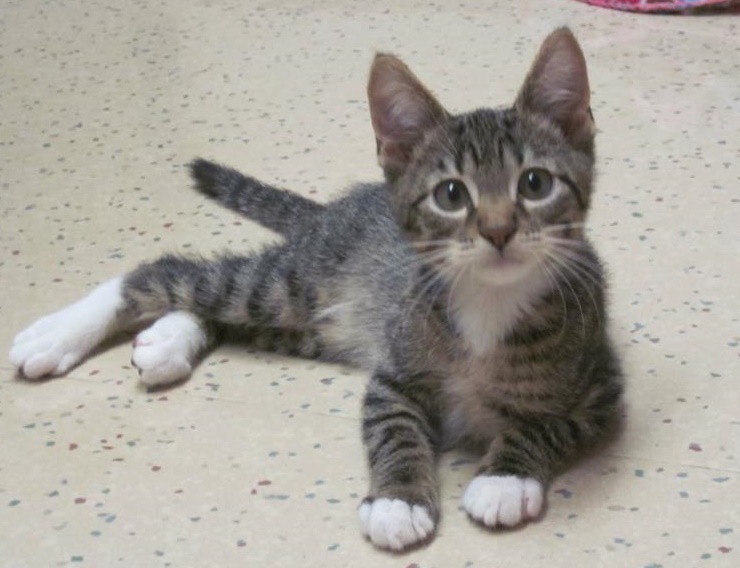 Proper litter box care is an essential part of proper care for your feline friend. If your cat is eliminating outside of the litter box, this means there may have an underlying medical condition and you should take your feline to your veterinarian. If a medical condition is ruled out, there are many things you can do at home to make sure you have the right set up to ensure your cat will use the litter box.
Proper litter box care is an essential part of proper care for your feline friend. If your cat is eliminating outside of the litter box, this means there may have an underlying medical condition and you should take your feline to your veterinarian. If a medical condition is ruled out, there are many things you can do at home to make sure you have the right set up to ensure your cat will use the litter box.
How many litter boxes should I have?
The ideal number of litter boxes is one per cat, plus one. So if you have 2 cats, you should have three litter boxes. If you have 4 cats, you should have five litter boxes, and so on.
Where should I place my litter boxes?
Litter boxes should be placed in at least two different locations. If you have multiple levels in your home, consider placing a litter box on each level of the home. Locations should be private and have easy access. Avoid noisy appliances and doors that are opened frequently. Boxes should not be placed next to one another, as cats will only see this as one giant litter box.
What type of litter should I use?
Most cats prefer a fine-grained, unscented litter (e.g., clumping litter). Many cats prefer a litter depth of approximately 1.5 inches. Preference may vary by cat.
How often should I clean the litter box?
Boxes should be scooped 1-2 times daily. Litter should be completely changed once a week or more often if a multi-cat household. Wash litter box with warm, soapy water and dry well before adding new litter.
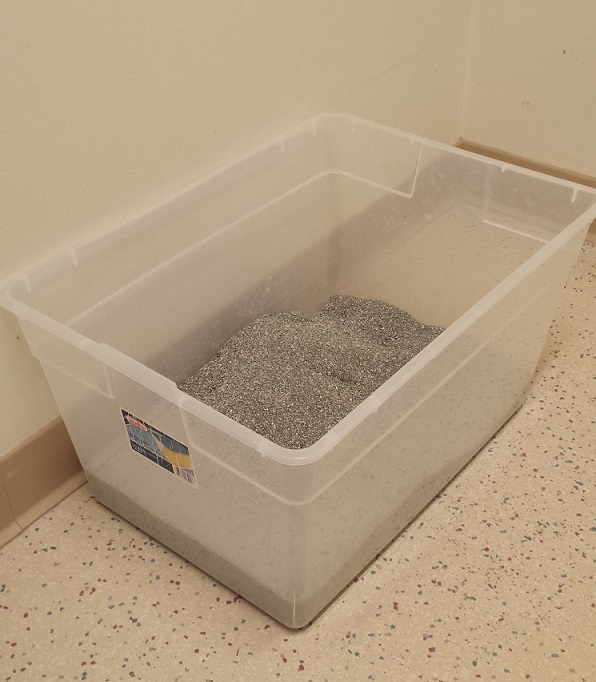
What kind of litter box should I buy?
Cats prefer litter boxes that are at least 1.5 times the length of their bodies. Commercial litter boxes are too small for larger cats! Sweater storage boxes, cement mixing tubs and small dog litter pans all make excellent cat litter boxes.
Are my cat’s potty habits normal?
The average cat urinates twice daily (+/- 2) and defecates once daily. Some will sniff and cover their eliminations; others don’t. Both are considered normal behavior.
Eliminating outside the box often signals an underlying medical condition. The earlier the problem is corrected, the better the chance for the cat to return to their litter box.
Acupuncture: What Is It And How Can Your Pet Benefit From It?
What is Acupuncture?
Acupuncture is the insertion of fine needles into specific points on a patient to produce a physiological response. It is an ancient Chinese medical technique that has been used for over 3,000 years. It is known to have therapeutic effects in a wide variety of animal diseases and is a valuable tool in veterinary medicine.
How does it work?
Acupuncture is the stimulation of specific points on the body located along pathways that correspond to specific organs. In traditional Oriental medicine, acupuncture is based on the flow of energy, or “Chi”, running through channels called meridians. These can be thought of as rivers of energy. These rivers can become blocked like a dam and acupuncture releases the obstruction.
In modern scientific terms, placing needles in designated points on the body will lead to the release of chemicals in the muscles, spinal cord, and brain, which can stimulate healing. It has been shown to increase blood and lymphatic flow to tissue, stimulate nerve function, increase the release of neurotransmitters and pain 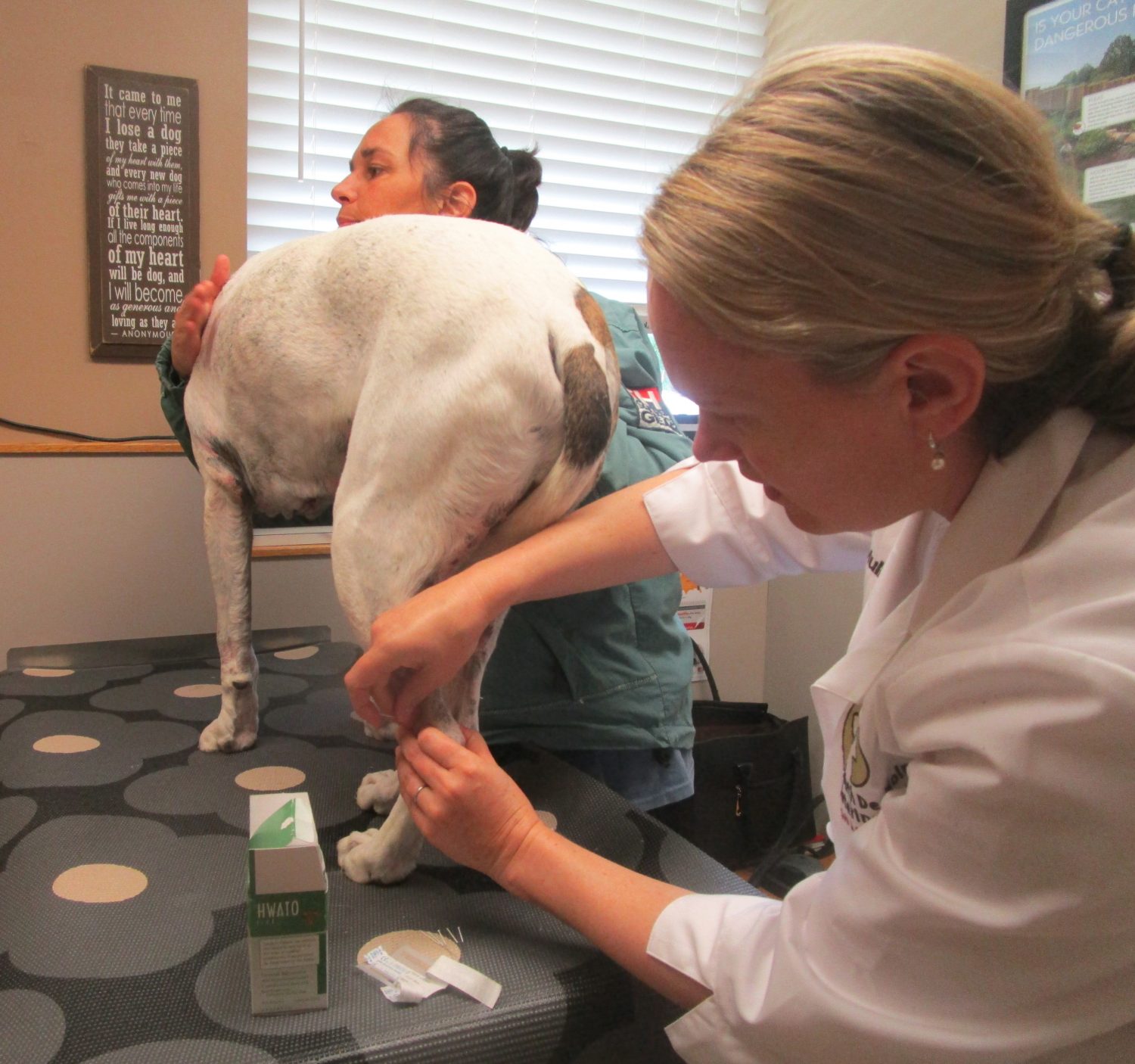 modulators, influence inflammatory responses and help release hormones.
modulators, influence inflammatory responses and help release hormones.
Acupuncture is typically used in conjunction with traditional western veterinary medicine.
Common conditions that respond well to acupuncture include:
- Musculoskeletal problems (osteoarthritis, intervertebral disc disease)
- Neurological problems (nerve injury, degenerative neurological conditions)
- Immune system disorders (allergies, skin conditions)
- Systemic diseases (bladder problems, chronic kidney disease, liver disease)
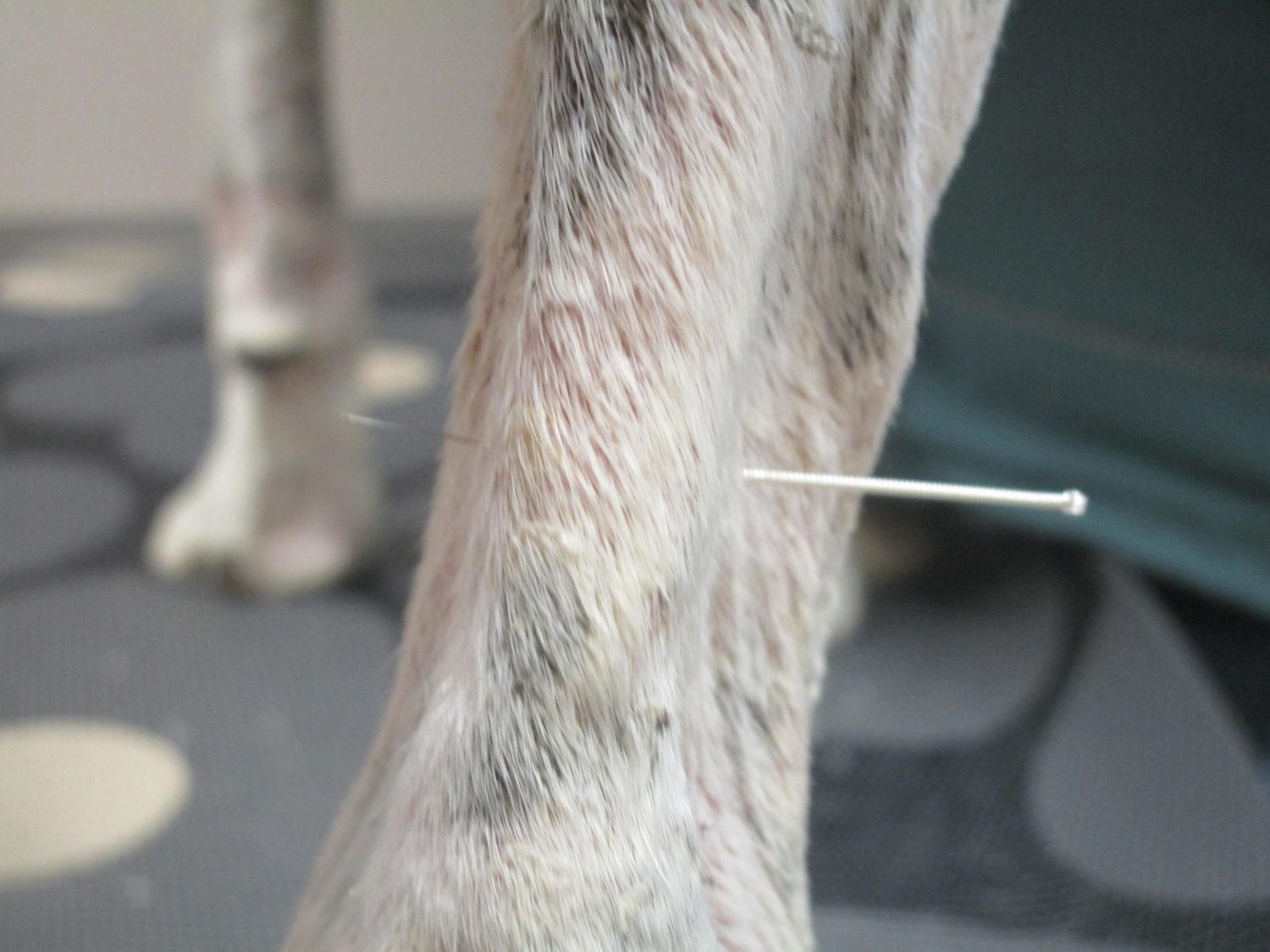
To set up an acupuncture treatment for your pet click here
Pets & Children: How to Properly Interact With One Another
A pet can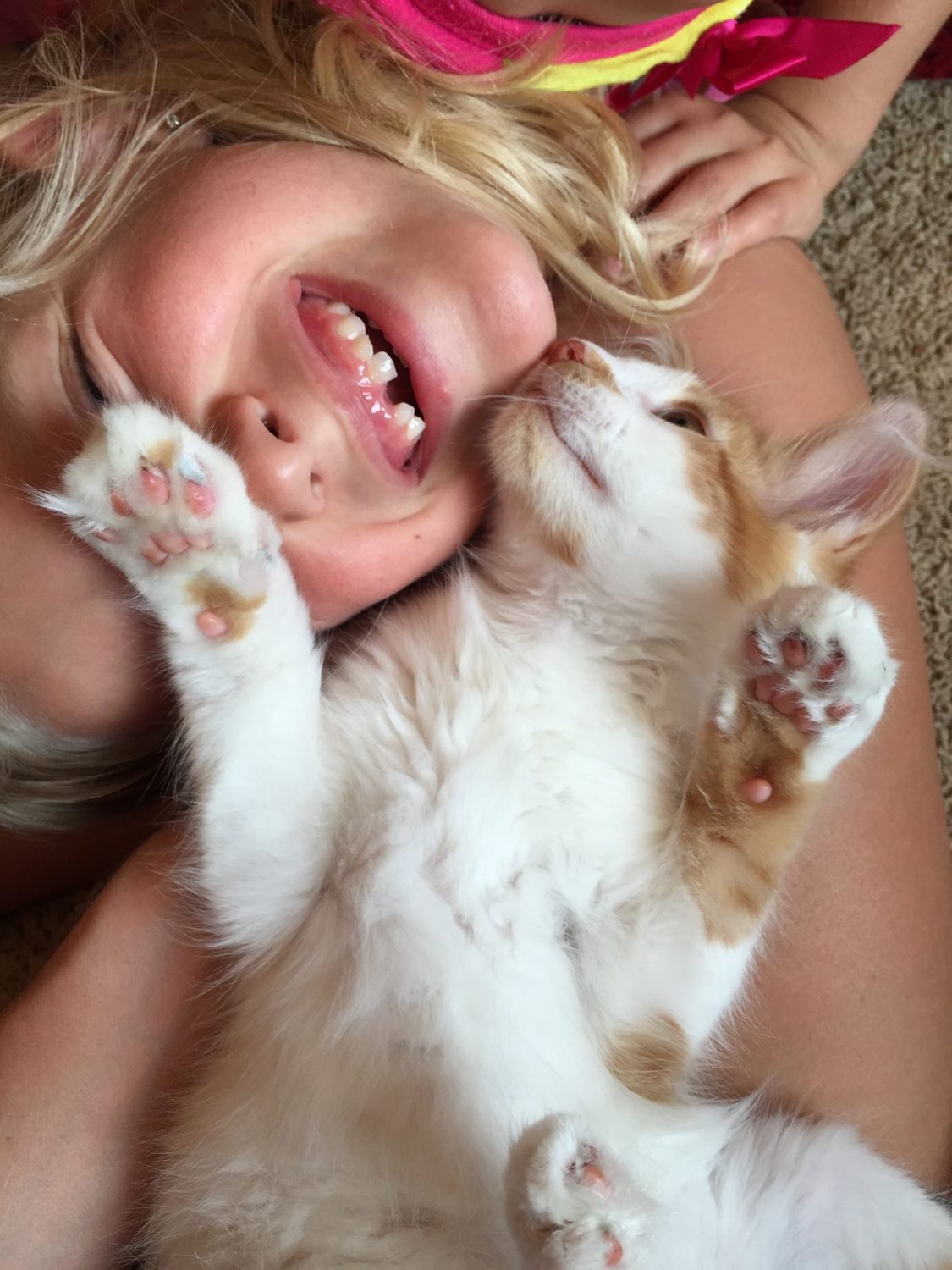 be a very rewarding and positive experience for children. It teaches a child compassion and responsibility and they also gain a companion. Research indicates that children growing up with well-cared-for dogs have mental and emotional advantages that extend throughout life. As a parent, you must be the one to decide the appropriate time to introduce a pet to the family. This decision should be based on your child’s age, maturity, behavior and interest.
be a very rewarding and positive experience for children. It teaches a child compassion and responsibility and they also gain a companion. Research indicates that children growing up with well-cared-for dogs have mental and emotional advantages that extend throughout life. As a parent, you must be the one to decide the appropriate time to introduce a pet to the family. This decision should be based on your child’s age, maturity, behavior and interest.
No child under school age should be left alone with pet. They are not yet at the age where they understand that their actions can hurt an animal. Even older children may test the boundaries of what they can get away with when adults aren’t watching. The best thing you can do is teach both your children and your pets what is appropriate behavior.
Some things you should never allow a child to do in your home:
- Pulling on ears, feet or tail
- Poking eyes or messing with their mouth
- Swing objects toward or near a pet
- Chase the pet
- Tug or otherwise compete with the pet for toys, food or other items
- Disturb a pet while they are sleeping or eating
- Enter a private area (crate or special room) designated as a child-free zone
- Put significant weight on a pet (“ride a dog like a horse”, etc)
- Suddenly get in a pet’s face
- Touch a pet that is in pain or afraid
Here are some tips on how to properly interact with pet.
- Ask! Teach your child to ask before petting a new or unfamiliar dog. If the owner says “no”, respect their decision as it may be in everyone’s best interest and safety.
- Petting: Stroke along the neck, back and sides (avoid the face and head)
- Act Like A Tree: Teach your child not to run if approached by a strange dog, but rather stand still and stare straight ahead until the dog leaves. Running away can provoke the dog to chase and attack.
- Chores: Having a child brush the dog or cleaning out the cat litter box (wearing gloves and washing properly afterwards). This will allow your child to bond with your pet and also teaches them responsibility.
- Training: Involve your child when teaching your dog commands. This is a rewarding experience for both the pet and the child.
Children are by far the most common victims of dog bites. Most bites occur doing everyday activities and with familiar pets. If we teach our children and our pets how to properly interact with one another, we can prevent bites from happening and ensure the human-animal bond.
Infographic on How Kids Should Interact With Pets
For more information on proper ways for kids and pets to interact, visit Dr. Sophia Yin’s Webpage.
Ten Tips for Preventing Pet Behavior Problems
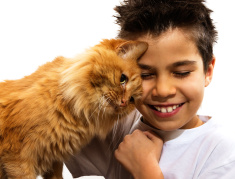
Getting a new pet is an exciting time for both your family and your new furry friend. Whether you have added a young kitten or a mature dog to your home, establishing rules and boundaries are important from the very first day. Here are 10 tips to help prevent behavior problems.
- Set rules immediately and stick to them.
- Avoid situations that promote inappropriate behavior.
- Observe the pet and provide what it needs to be cared for and attended to
- Supervise the new pet diligently through undivided individual attention and training, and restrict the pet’s access to a limited area of the house until training is complete.
- Encourage good behavior with praise and attention.
- Correct bad behaviors by providing positive alternatives. (A toy for a slipper, scratching post for the sofa)
- Never physically punish or force compliance to commands. This may lead to fear biting or aggression.
- Don’t play rough or encourage aggression or play biting.
- Expose pets to people, animals, and environments where you want them to live.
- See your veterinarian if serious or unresolved behavior problems exist.
Gentle Leader Headcollar: Walk Your Canine With Ease
Does your dog pull when walking on a leash? Do you have problems keeping control and end up being more exhausted by the end of the walk than your canine companion? Consider training with a Gentle Leader Headcollar to help teach your dog better leash manners.
How does a Gentle Leader Headcollar work?
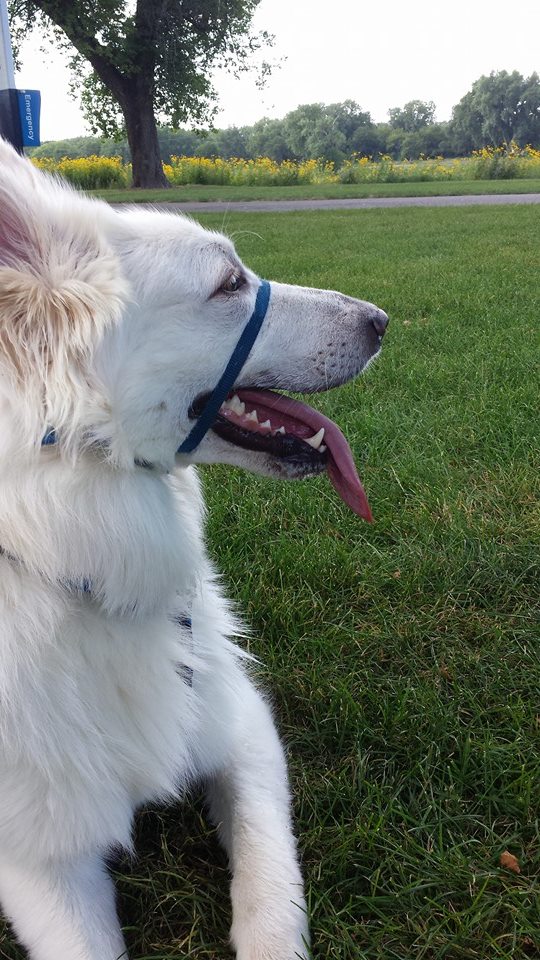
The Gentle Leader Headcollar can be a great training tool for walking your pup.
The Gentle Leader headcollar has been designed to work with a dog’s natural instincts to control unwanted behavior. The nose loop encircles your dog’s muzzle so that when he tugs on the leash, it redirects his head toward you when he pulls forward. This prevents pulling and directs his attention back to you.
What are the advantages of a Gentle Leader Headcollar?
–Stops pulling on the leash. With the headcollar, you steer your dog’s nose and the body will follow. It’s very difficult for a dog to drag his handler down the street when his head is turned.
–Control. You only have to compete with the strength of a dog’s neck and head not all of the power packed in the body. This makes it easier to walk big or strong dogs.
–Safety. Unlike choke chains or prong collars, the headcollar is safe to use on puppies as young as 8 weeks old. There is very little pressure applied to the dog’s muzzle and no pressure on the throat.
–Flexibility. It can be sized to fit all dogs with an adjustable nose loop. And you have the option to convert the headcollar to a regular collar if desired.
–Comfort. The headcollar eliminates uncomfortable pressure on the throat when pulling on a standard collar. It is a positive, no-pain option for controlling a dog.
How do I acclimate my dog to the Gentle Leader Headcollar?
It’s very important that you acclimate your dog slowly to the headcollar. In the beginning, put the headcollar on him several times a day for 2-3 minutes, give him treats, throw a toy, feed him, etc while he has it on. At the end of your training period, if he is NOT struggling, take the headcollar off. Never take it off if he is struggling, because then you are rewarding for struggling.
Gradually increase the amount of time he wears it around the house and then begin putting it on at the end of your walks when he is tired. Increase the amount of time he wears it toward the end of the walk until you are actually putting it on at the beginning. If he tries to rub his nose on your leg or sweep his head through the grass, don’t let him. Lift up on the leash, and then loosen the leash and praise when he stops. Above all, make the time he has the headcollar on, FUN!
Where can I buy a Gentle Leader Headcollar?
–Animal Rescue League of Iowa, most local pet stores or online.
Top 5 Pet Poisons
March is Pet Poison Prevention Month. Like children, we must keep certain items out of reach of our pets in order to keep them safe. Some items you may be aware of their toxicity to pets and some may be a surprise. Continue below to find out if you know the top five pet toxins.
HUMAN FOODS: Many foods that are perfectly safe for humans can be harmful to our pets. These include:
- Chocolate

- Grapes and raisins
- Garlic and onion
- Yeast dough
- Any products containing the artificial sweetener, xylitol. (Found in a variety of foods from gum to toothpaste, including some brand of peanut butter)
- Pork products (Double check your treats and rawhide products as pork is a popular flavor used in pet products)
- Mushrooms
- Caffeinated items
- Nuts
HUMAN MEDICATIONS: There are several over the counter drugs and prescriptions that can do more harm than good. Please contact your veterinarian before giving any type of medication to your pet. Here are a few of the most common you should keep out of your pet’s reach:
- Acetaminophen (Tylenol)

- Ibuprofen
- Naproxen (Aleve)
- Antidepressants
- Pseudoephedrine
PLANTS: Greenery adds a little bit of extra life to our homes, but keep them up high and out of reach of your pets as they may find them to be a tasty snack.
- Lilies
- Azaleas
- Tulips

- Baby’s breath
- Carnations
- Hydrangeas
- Hyacinth
- Chamomile
- Ivy
AUTOMOTIVE PRODUCTS: Antifreeze and coolants, even in small quantities, can be fatal to your pet. Dogs and cats love the sweet taste of these toxic substances. keep those out of reach of your pet, and keep your pet away from the garage floor where the liquid may leak out of your vehicle.
OVER THE COUNTER FLEA AND TICK PRODUCTS: There are an overwhelming amount of options when it comes to flea and tick control. The products from your veterinarian are your safest options (Nexgard, Frontline Plus, Revolution and Seresto) when administered properly and with correct dosage. Many other flea and tick products that you can find at Wal-Mart or PetSmart you should avoid. Most of these products are ineffective and can have harmful side effects. Some of the most common brands you should avoid include: 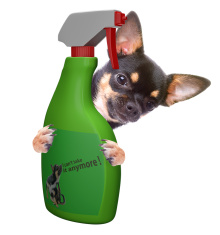
- Hartz
- Adams
- Sentry
If you are concerned that your pet may have been harmed by one of these products, please call your veterinarian immediately, or call the Pet Poison Helpline: 855-764-7661
Renovation To Expand Doggy Daycare
If you have visited our clinic in the last couple of months you have probably noticed some construction taking place. We appreciate everyone’s patience during the renovation and we are very excited to share with you what it is all about.
Why are we renovating?
Since we are restricted in expanding our building outward, renovating the inside allows us to better utilize the space we have to better suit the needs of our patients. One of these needs is our Doggy Daycare program.
What specifically is being renovated?
In 2010 we started promoting Doggy Daycare at our clinic. It began with Bella, a Vizsla whose family’s previous dog Continue…


